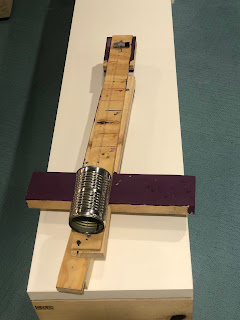This is the second Action Project for my STEAM course this term, Light, Sound, and Time. This unit was unsurprisingly about sound! We have learned a lot in this unit and it has built well upon the last unit. We learned about sound waves, how they move, and how they are different from light waves. Sound waves are longitudinal, meaning they crest in the direction that they are moving. We also learned about how sound interacts with objects. The Doppler Effect is a property where an object moving sounds higher pitched when it approaches because the waves are more bunched up. We learned about mach speed, which is when something is going faster than the speed of sound. It moves faster than the sound waves it creates. We also learned how sound works in instruments, which is connected to our Action Project. For this project, we have been tasked with creating a Diddley Bow, a one-string instrument. Here is mine!
L.A.H., Diddley Bow Top View, 2023
L.A.H., Diddley Bow Side View, 2023
My diddley bow creates sound by having a very tense guitar string nailed to both ends of a board of wood. A can is on one end of the board and that space is what creates the sound. You can create pitches by putting pressure at various places on the string. This changes the wavelength and as a by-product, the frequency changes. The Diddley Bow exemplifies many of the things we learned about this unit. This demonstrates the principles of class because the string is a sort of wave and we change the wave’s wavelength when we put pressure on the various points on it. These are marked on the Diddley Bow and are called harmonics. We can affect the pitch by affecting the wavelength. The sound waves reverberate around inside the can and then are pushed out. This causes the sort of musical sound you hear. Additionally, sounds travel much faster in steel, which is what the string is made out of, than air. This is what makes strumming the string much different from just moving the air and is what causes that sound. Below is a recording of me playing the Diddley Bow and how the pitch changed with the wavelength.
Here is the math behind my Diddley Bow!
string=21in
H of battery side string=0.75in
H of can side string=1.75in
Area=21/2*(0.75+1.75)=26.25in^2
Diameter of can=3.25in
Radius of can=1.625in
H of can=5in
Volume=pi*1.625^2*5=41.4788405in^3
Frequency of open note= 101
Width of string=0.05in
Sides of triangle: 1, 21, sqrt(1^2+21^2)=21.023796
Angles of Trapezoid: 90, 90, tan^-1(21/1)=87.274, 360-90-90-87.274=92.726
Here is a labeled drawing of my Diddley Bow, containing all the parts as well as the trapezoid it creates:
L.A.H., Diddley Bow Drawing, 2023
Here is a depiction of the harmonics that are created on my Diddley Bow, as well as their frequency and wavelengths:
L.A.H., Harmonics, 2023
This project was very fun! I had a very good time making my Diddley Bow, and the math behind it is very interesting. I had a slight struggle with the initial piece of wood I chose being too thin to support the tension, as can be seen in the side image by the part that has no support bending, but I had a good time solving that. Additionally, it created a unique and interesting instrument I am proud of. If I were to do this project again, I might try and do two strings because I feel like that would be interesting. The next unit is time and I am very excited, so stick around!


.jpg)
.jpg)

Comments
Post a Comment